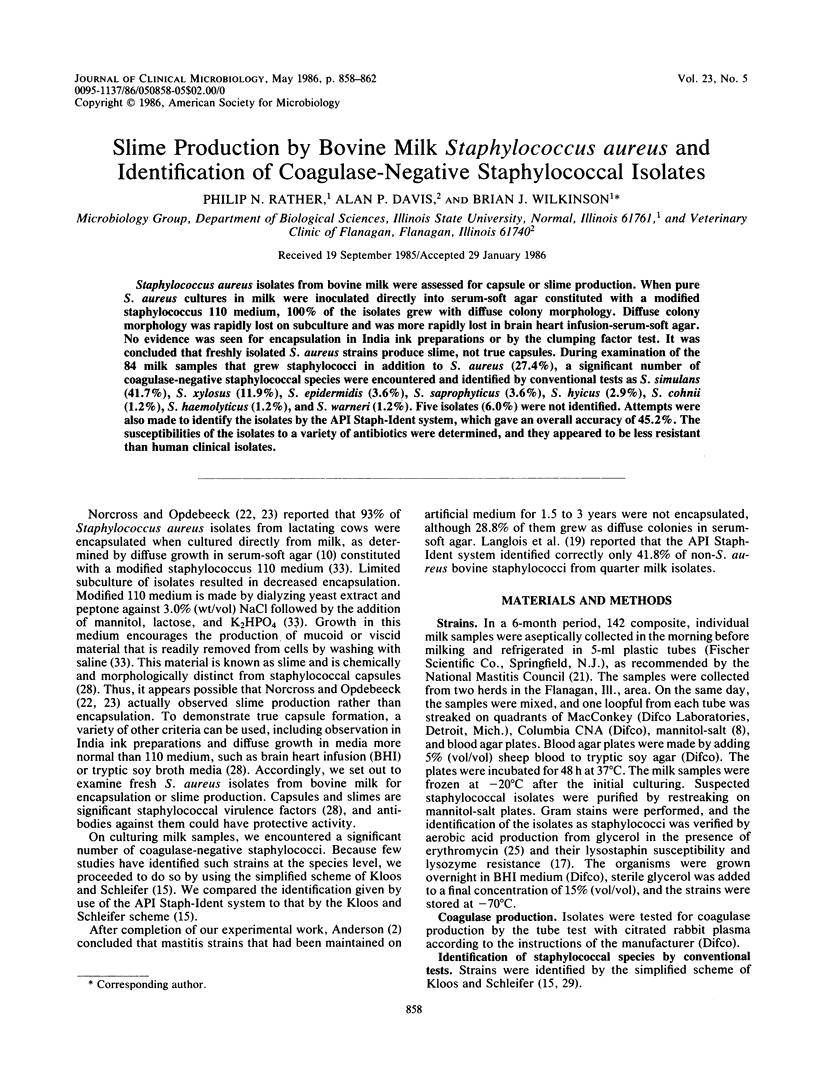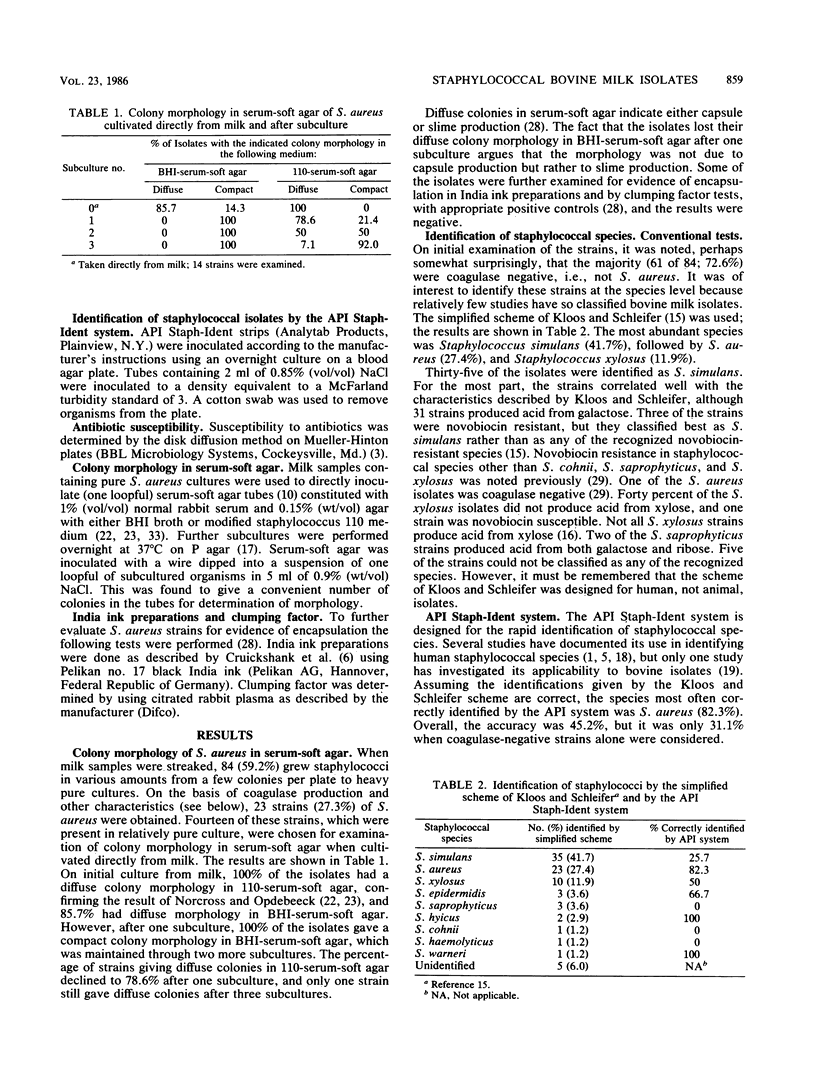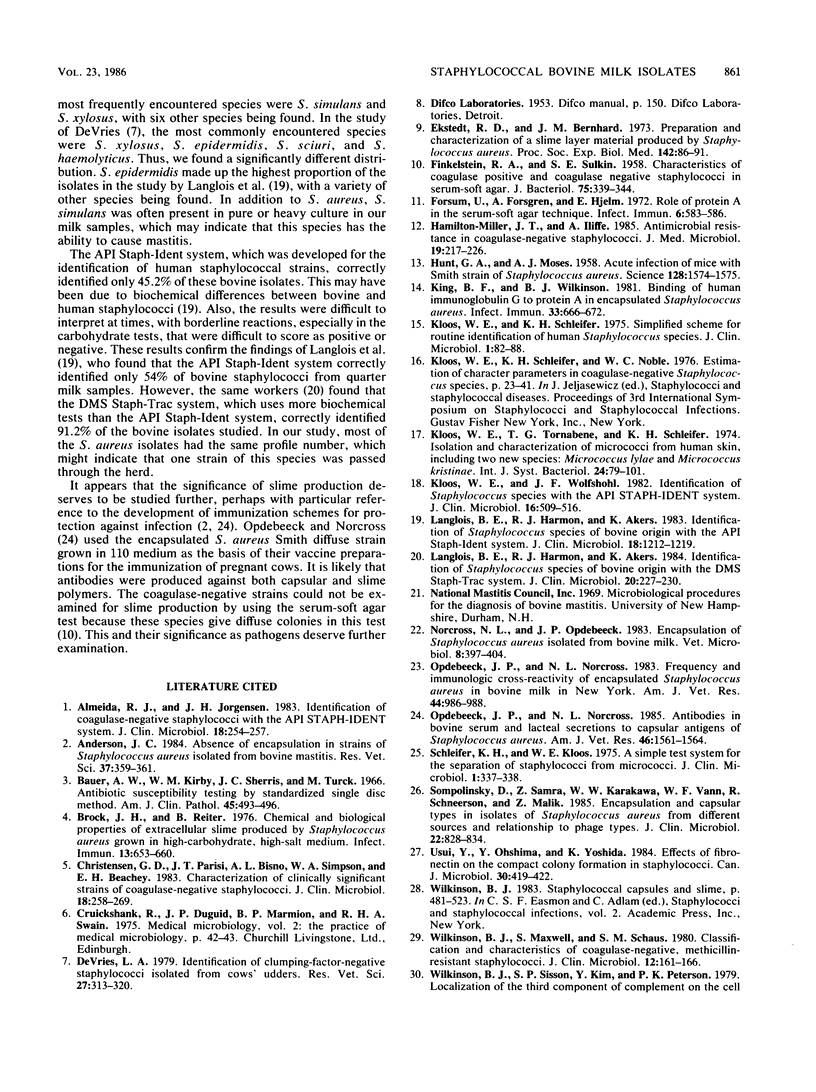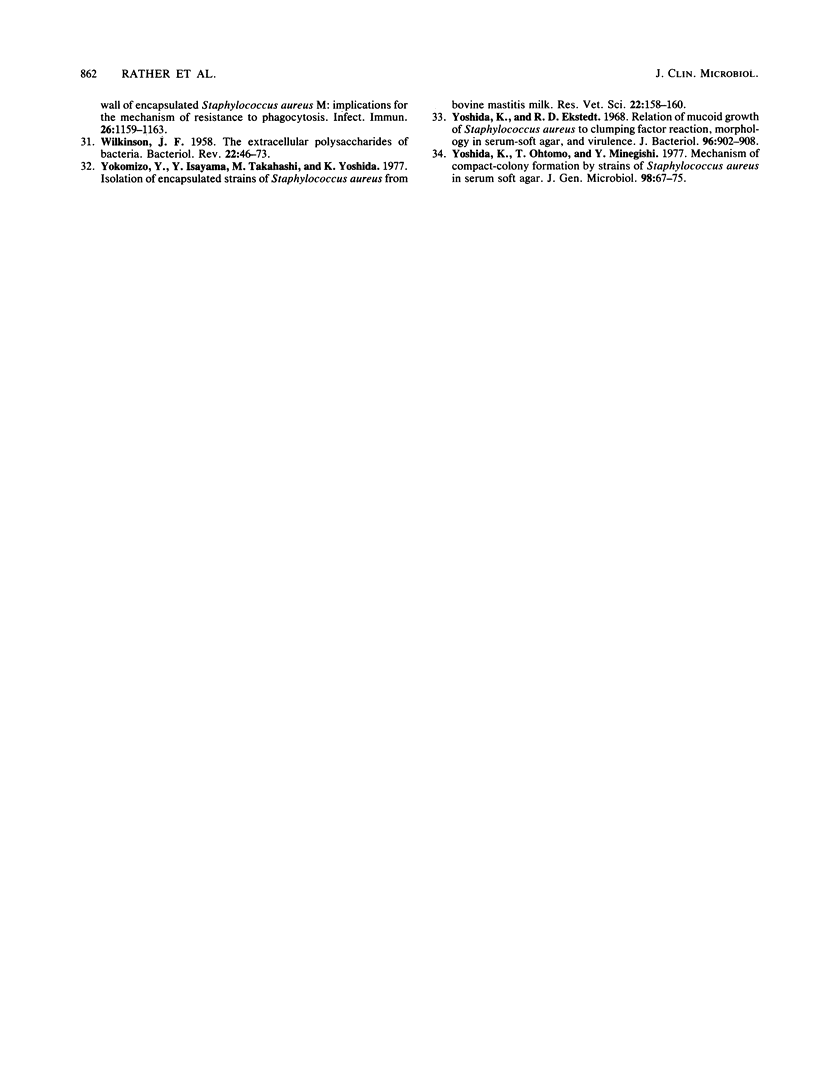Abstract
Staphylococcus aureus isolates from bovine milk were assessed for capsule or slime production. When pure S. aureus cultures in milk were inoculated directly into serum-soft agar constituted with a modified staphylococcus 110 medium, 100% of the isolates grew with diffuse colony morphology. Diffuse colony morphology was rapidly lost on subculture and was more rapidly lost in brain heart infusion-serum-soft agar. No evidence was seen for encapsulation in India ink preparations or by the clumping factor test. It was concluded that freshly isolated S. aureus strains produce slime, not true capsules. During examination of the 84 milk samples that grew staphylococci in addition to S. aureus (27.4%), a significant number of coagulase-negative staphylococcal species were encountered and identified by conventional tests as S. simulans (41.7%), S. xylosus (11.9%), S. epidermidis (3.6%), S. saprophyticus (3.6%), S. hyicus (2.9%), S. cohnii (1.2%), S. haemolyticus (1.2%), and S. warneri (1.2%). Five isolates (6.0%) were not identified. Attempts were also made to identify the isolates by the API Staph-Ident system, which gave an overall accuracy of 45.2%. The susceptibilities of the isolates to a variety of antibiotics were determined, and they appeared to be less resistant than human clinical isolates.
Full text
PDF




Selected References
These references are in PubMed. This may not be the complete list of references from this article.
- Almeida R. J., Jorgensen J. H. Identification of coagulase-negative staphylococci with the API STAPH-IDENT system. J Clin Microbiol. 1983 Aug;18(2):254–257. doi: 10.1128/jcm.18.2.254-257.1983. [DOI] [PMC free article] [PubMed] [Google Scholar]
- Anderson J. C. Absence of encapsulation in strains of Staphylococcus aureus isolated from bovine mastitis. Res Vet Sci. 1984 Nov;37(3):359–361. [PubMed] [Google Scholar]
- Bauer A. W., Kirby W. M., Sherris J. C., Turck M. Antibiotic susceptibility testing by a standardized single disk method. Am J Clin Pathol. 1966 Apr;45(4):493–496. [PubMed] [Google Scholar]
- Brock J. H., Reiter B. Chemical and biological properties of extracellular slime produced by Staphylococcus aureus grown in high-carbohydrate, high-salt medium. Infect Immun. 1976 Mar;13(3):653–660. doi: 10.1128/iai.13.3.653-660.1976. [DOI] [PMC free article] [PubMed] [Google Scholar]
- Christensen G. D., Parisi J. T., Bisno A. L., Simpson W. A., Beachey E. H. Characterization of clinically significant strains of coagulase-negative staphylococci. J Clin Microbiol. 1983 Aug;18(2):258–269. doi: 10.1128/jcm.18.2.258-269.1983. [DOI] [PMC free article] [PubMed] [Google Scholar]
- Devriese L. A. Identification of clumping-factor-negative staphylococci isolated from cows' udders. Res Vet Sci. 1979 Nov;27(3):313–320. [PubMed] [Google Scholar]
- Ekstedt R. D., Bernhard J. M. Preparation and characterization of a slime layer material produced by Staphylococcus aureus. Proc Soc Exp Biol Med. 1973 Jan;142(1):86–91. doi: 10.3181/00379727-142-36964. [DOI] [PubMed] [Google Scholar]
- FINKELSTEIN R. A., SULKIN S. E. Characteristics of coagulase positive and coagulase negative staphylococci in serum-soft agar. J Bacteriol. 1958 Mar;75(3):339–344. doi: 10.1128/jb.75.3.339-344.1958. [DOI] [PMC free article] [PubMed] [Google Scholar]
- Forsum U., Forsgren A., Hjelm E. Role of protein A in the serum-soft agar technique. Infect Immun. 1972 Oct;6(4):583–586. doi: 10.1128/iai.6.4.583-586.1972. [DOI] [PMC free article] [PubMed] [Google Scholar]
- HUNT G. A., MOSES A. J. Acute infection of mice with Smith strain of Staphylococcus aureus. Science. 1958 Dec 19;128(3338):1574–1575. doi: 10.1126/science.128.3338.1574. [DOI] [PubMed] [Google Scholar]
- Hamilton-Miller J. M., Iliffe A. Antimicrobial resistance in coagulase-negative staphylococci. J Med Microbiol. 1985 Apr;19(2):217–226. doi: 10.1099/00222615-19-2-217. [DOI] [PubMed] [Google Scholar]
- King B. F., Wilkinson B. J. Binding of human immunoglobulin G to protein A in encapsulated Staphylococcus aureus. Infect Immun. 1981 Sep;33(3):666–672. doi: 10.1128/iai.33.3.666-672.1981. [DOI] [PMC free article] [PubMed] [Google Scholar]
- Kloos W. E., Schleifer K. H. Simplified scheme for routine identification of human Staphylococcus species. J Clin Microbiol. 1975 Jan;1(1):82–88. doi: 10.1128/jcm.1.1.82-88.1975. [DOI] [PMC free article] [PubMed] [Google Scholar]
- Kloos W. E., Wolfshohl J. F. Identification of Staphylococcus species with the API STAPH-IDENT system. J Clin Microbiol. 1982 Sep;16(3):509–516. doi: 10.1128/jcm.16.3.509-516.1982. [DOI] [PMC free article] [PubMed] [Google Scholar]
- Langlois B. E., Harmon R. J., Akers K. Identification of Staphylococcus species of bovine origin with the API Staph-Ident system. J Clin Microbiol. 1983 Nov;18(5):1212–1219. doi: 10.1128/jcm.18.5.1212-1219.1983. [DOI] [PMC free article] [PubMed] [Google Scholar]
- Langlois B. E., Harmon R. J., Akers K. Identification of Staphylococcus species of bovine origin with the DMS Staph-Trac system. J Clin Microbiol. 1984 Aug;20(2):227–230. doi: 10.1128/jcm.20.2.227-230.1984. [DOI] [PMC free article] [PubMed] [Google Scholar]
- Norcross N. L., Opdebeeck J. P. Encapsulation of Staphylococcus aureus isolated from bovine milk. Vet Microbiol. 1983 Aug;8(4):397–404. doi: 10.1016/0378-1135(83)90052-4. [DOI] [PubMed] [Google Scholar]
- Opdebeeck J. P., Norcross N. L. Antibodies in bovine serum and lacteal secretions to capsular antigens of Staphylococcus aureus. Am J Vet Res. 1985 Jul;46(7):1561–1564. [PubMed] [Google Scholar]
- Opdebeeck J. P., Norcross N. L. Frequency and immunologic cross-reactivity of encapsulated Staphylococcus aureus in bovine milk in New York. Am J Vet Res. 1983 Jun;44(6):986–988. [PubMed] [Google Scholar]
- Schleifer K. H., Kloos W. E. A simple test system for the separation of staphylococci from micrococci. J Clin Microbiol. 1975 Mar;1(3):337–338. doi: 10.1128/jcm.1.3.337-338.1975. [DOI] [PMC free article] [PubMed] [Google Scholar]
- Sompolinsky D., Samra Z., Karakawa W. W., Vann W. F., Schneerson R., Malik Z. Encapsulation and capsular types in isolates of Staphylococcus aureus from different sources and relationship to phage types. J Clin Microbiol. 1985 Nov;22(5):828–834. doi: 10.1128/jcm.22.5.828-834.1985. [DOI] [PMC free article] [PubMed] [Google Scholar]
- Usui Y., Ohshima Y., Yoshida K. Effects of fibronectin on the compact colony formation in staphylococci. Can J Microbiol. 1984 Mar;30(3):419–422. doi: 10.1139/m84-062. [DOI] [PubMed] [Google Scholar]
- WILKINSON J. F. The extracellualr polysaccharides of bacteria. Bacteriol Rev. 1958 Mar;22(1):46–73. doi: 10.1128/br.22.1.46-73.1958. [DOI] [PMC free article] [PubMed] [Google Scholar]
- Wilkinson B. J., Maxwell S., Schaus S. M. Classification and characteristics of coagulase-negative, methicillin-resistant staphylococci. J Clin Microbiol. 1980 Aug;12(2):161–166. doi: 10.1128/jcm.12.2.161-166.1980. [DOI] [PMC free article] [PubMed] [Google Scholar]
- Yokomizo Y., Isayama Y., Takahashi M., Yoshida K. Isolation of encapsulated strains of Staphylococcus aureus from bovine mastitis milk. Res Vet Sci. 1977 Mar;22(2):158–160. [PubMed] [Google Scholar]
- Yoshida K., Ekstedt R. D. Relation of mucoid growth of Staphylococcus aureus to clumping factor reaction, morphology in serum-soft agar, and virulence. J Bacteriol. 1968 Oct;96(4):902–908. doi: 10.1128/jb.96.4.902-908.1968. [DOI] [PMC free article] [PubMed] [Google Scholar]
- Yoshida K., Ohtomo T., Minegishi Y. Mechanism of compact-colony formation by strains of Staphylococcus aureus in serum soft agar. J Gen Microbiol. 1977 Jan;98(1):67–75. doi: 10.1099/00221287-98-1-67. [DOI] [PubMed] [Google Scholar]


